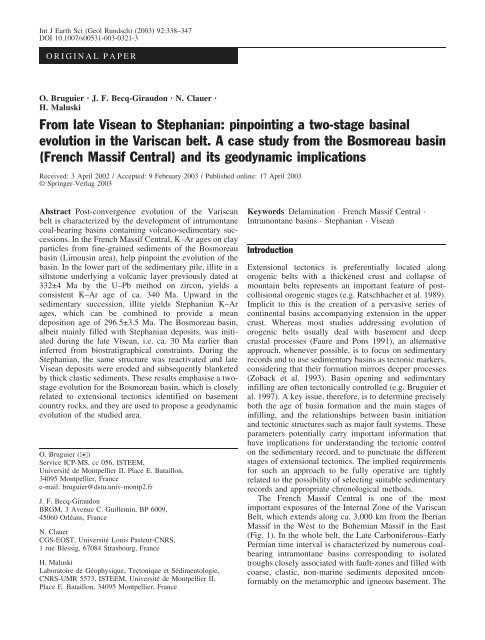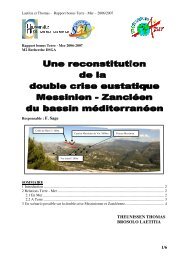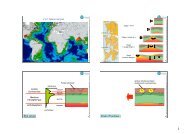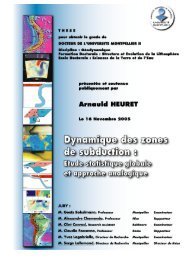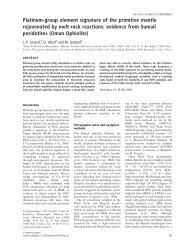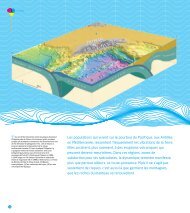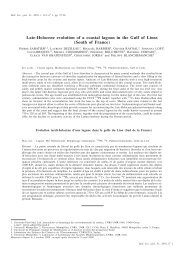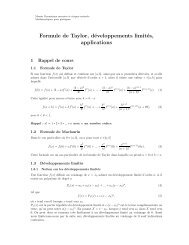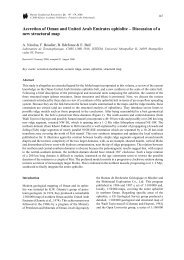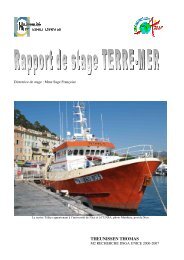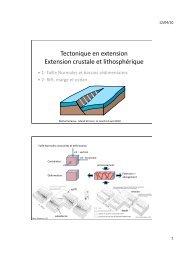Géochronologie U-Pb par ablation laser et ICP-MS (LA-ICP-MS ...
Géochronologie U-Pb par ablation laser et ICP-MS (LA-ICP-MS ...
Géochronologie U-Pb par ablation laser et ICP-MS (LA-ICP-MS ...
You also want an ePaper? Increase the reach of your titles
YUMPU automatically turns print PDFs into web optimized ePapers that Google loves.
Int J Earth Sci (Geol Rundsch) (2003) 92:338–347<br />
DOI 10.1007/s00531-003-0321-3<br />
ORIGINAL PAPER<br />
O. Bruguier · J. F. Becq-Giraudon · N. Clauer ·<br />
H. Maluski<br />
From late Visean to Stephanian: pinpointing a two-stage basinal<br />
evolution in the Variscan belt. A case study from the Bosmoreau basin<br />
(French Massif Central) and its geodynamic implications<br />
Received: 3 April 2002 / Accepted: 9 February 2003 / Published online: 17 April 2003<br />
Springer-Verlag 2003<br />
Abstract Post-convergence evolution of the Variscan<br />
belt is characterized by the development of intramontane<br />
coal-bearing basins containing volcano-sedimentary successions.<br />
In the French Massif Central, K–Ar ages on clay<br />
<strong>par</strong>ticles from fine-grained sediments of the Bosmoreau<br />
basin (Limousin area), help pinpoint the evolution of the<br />
basin. In the lower <strong>par</strong>t of the sedimentary pile, illite in a<br />
siltstone underlying a volcanic layer previously dated at<br />
332€4 Ma by the U–<strong>Pb</strong> m<strong>et</strong>hod on zircon, yields a<br />
consistent K–Ar age of ca. 340 Ma. Upward in the<br />
sedimentary succession, illite yields Stephanian K–Ar<br />
ages, which can be combined to provide a mean<br />
deposition age of 296.5€3.5 Ma. The Bosmoreau basin,<br />
albeit mainly filled with Stephanian deposits, was initiated<br />
during the late Visean, i.e. ca. 30 Ma earlier than<br />
inferred from biostratigraphical constraints. During the<br />
Stephanian, the same structure was reactivated and late<br />
Visean deposits were eroded and subsequently blank<strong>et</strong>ed<br />
by thick clastic sediments. These results emphasise a twostage<br />
evolution for the Bosmoreau basin, which is closely<br />
related to extensional tectonics identified on basement<br />
country rocks, and they are used to propose a geodynamic<br />
evolution of the studied area.<br />
O. Bruguier () )<br />
Service <strong>ICP</strong>-<strong>MS</strong>, cc 056, ISTEEM,<br />
UniversitØ de Montpellier II, Place E. Bataillon,<br />
34095 Montpellier, France<br />
e-mail: bruguier@dstu.univ-montp2.fr<br />
J. F. Becq-Giraudon<br />
BRGM, 3 Avenue C. Guillemin, BP 6009,<br />
45060 OrlØans, France<br />
N. Clauer<br />
CGS-EOST, UniversitØ Louis Pasteur-CNRS,<br />
1 rue Blessig, 67084 Strasbourg, France<br />
H. Maluski<br />
Laboratoire de GØophysique, Tectonique <strong>et</strong> SØdimentologie,<br />
CNRS-UMR 5573, ISTEEM, UniversitØ de Montpellier II,<br />
Place E. Bataillon, 34095 Montpellier, France<br />
Keywords Delamination · French Massif Central ·<br />
Intramontane basins · Stephanian · Visean<br />
Introduction<br />
Extensional tectonics is preferentially located along<br />
orogenic belts with a thickened crust and collapse of<br />
mountain belts represents an important feature of postcollisional<br />
orogenic stages (e.g. Ratschbacher <strong>et</strong> al. 1989).<br />
Implicit to this is the creation of a pervasive series of<br />
continental basins accompanying extension in the upper<br />
crust. Whereas most studies addressing evolution of<br />
orogenic belts usually deal with basement and deep<br />
crustal processes (Faure and Pons 1991), an alternative<br />
approach, whenever possible, is to focus on sedimentary<br />
records and to use sedimentary basins as tectonic markers,<br />
considering that their formation mirrors deeper processes<br />
(Zoback <strong>et</strong> al. 1993). Basin opening and sedimentary<br />
infilling are often tectonically controlled (e.g. Bruguier <strong>et</strong><br />
al. 1997). A key issue, therefore, is to d<strong>et</strong>ermine precisely<br />
both the age of basin formation and the main stages of<br />
infilling, and the relationships b<strong>et</strong>ween basin initiation<br />
and tectonic structures such as major fault systems. These<br />
<strong>par</strong>am<strong>et</strong>ers potentially carry important information that<br />
have implications for understanding the tectonic control<br />
on the sedimentary record, and to punctuate the different<br />
stages of extensional tectonics. The implied requirements<br />
for such an approach to be fully operative are tightly<br />
related to the possibility of selecting suitable sedimentary<br />
records and appropriate chronological m<strong>et</strong>hods.<br />
The French Massif Central is one of the most<br />
important exposures of the Internal Zone of the Variscan<br />
Belt, which extends along ca. 3,000 km from the Iberian<br />
Massif in the West to the Bohemian Massif in the East<br />
(Fig. 1). In the whole belt, the Late Carboniferous–Early<br />
Permian time interval is characterized by numerous coalbearing<br />
intramontane basins corresponding to isolated<br />
troughs closely associated with fault-zones and filled with<br />
coarse, clastic, non-marine sediments deposited unconformably<br />
on the m<strong>et</strong>amorphic and igneous basement. The


